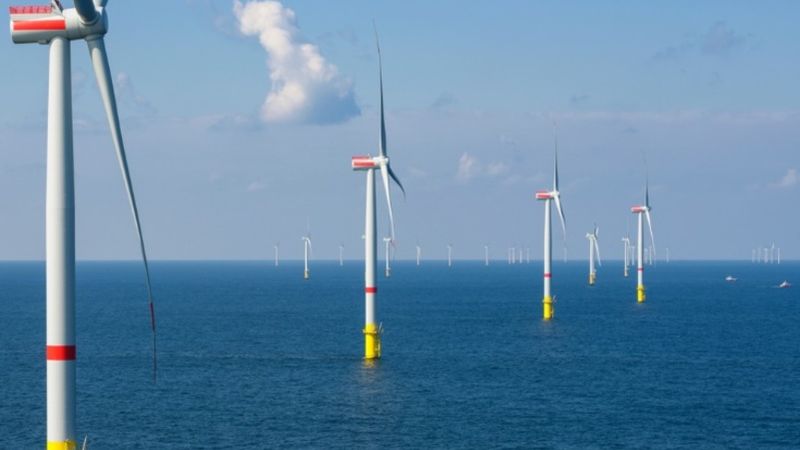How edge AI is enabling cutting-edge advances in sustainability.
Article #3 of the "Why Edge?" Series. From soaring costs to dwindling resources, the energy and utility sectors face unprecedented challenges in the coming years.
This is the third of a series of articles exploring the benefits of Edge AI for a variety of applications.
Climate change is putting pressure on water reserves like never before, while gas supplies and electricity production have been impacted by geopolitical instability and surging post-COVID-19 demand.
The key focus for businesses and governments alike is a strategic shift towards sustainably, where waste is minimized and efficiency is prioritized. Crucial to this new direction are advanced technologies such as edge AI.
By enabling the energy and utilities infrastructure to monitor efficiency and make real-time smart decisions, Internet of Things (IoT) devices equipped with edge AI capabilities can be one of the cornerstones of this new tech-enabled sustainability landscape.
The scale of the challenge
We live in a new world. Relentless global demand for resources means meeting basic needs such as stable access to water and electricity are becoming increasingly difficult even in developed nations. In August, the UK Met Office declared a drought emergency in the Southwest of England following the driest conditions in 90 years. It meant urging businesses and the public to conserve water as much as possible.
The European Commission also recently announced it was taking ‘extraordinary’ measures to intervene in European energy markets. This was due to the rocketing costs of gas and electricity brought about by surging post-pandemic demand and Russia’s invasion of Ukraine. The measures aimed to reduce demand for electricity while also imposing energy caps, and any additional demand-driven profits by energy companies redistributed to curb consumer costs.
The outlook is quite clear. Electricity, gas, and water will continue to be in high demand across both the developed and developing worlds, while supply is expected to remain constrained, so maximizing efficiency, both in consumption and production, will be of vital importance going forward.
Addressing the problem
So beyond being able to drastically reduce usage or secure more supplies from somewhere, what are the solutions to this global dilemma? Put simply – increased efficiency.
Electricity, gas, and water production and distribution requires hugely sophisticated operations with a many opportunities for waste and lack of efficiency at any stage of each process. To reduce waste and maximize efficiency, the whole process has to become smarter. A cost effictive way to accomplish this efficiency, safely, close to each production/redistribution step, and in a timely fashion is by using Internet of Things (IoT) devices.
IoT devices can be used to collect a whole range of information from sensing the flow pressure in a pipeline to detecting changes in temperature which could indicate an imminent disaster. But that information is most useful once it is turned into actionable data. This has traditionally been done in the Cloud, with the information collected by IoT devices being transmitted wirelessly to a data center, where artificial intelligence algorithms analyze the information and make decisions.
But relying on all information to be analyzed in the cloud can present a host of challenges. Firstly, the system is reliant on a stable wireless connection. Oftentimes in industrial settings, this is not guaranteed, especially as physical barriers may impact signal quality. Another challenge is the latency caused by the transmission of the information to the cloud and the respective transmission of the action back from the cloud to the point where information was collected. In safety critical cases, minutes and even seconds can mean the difference between averting a disaster or not. What is more, the transmission of large amounts of data consumes a lot of energy, which in turn can contribute to the energy scarcity problems that the industry aims to solve.
An answer to these challenges is edge technology – where the decision making, or inference capability, is contained in the IoT device iteself. Edge-AI on IoT is being implemented across a range of settings, from oil rigs to wind farms, and is helping to to streamline production, avoid waste, and spot safety concerns.
Examples of how this technology is being used today include:
- Edge enabled smart grids: IoT is used to monitor energy production and use across the grid, with AI making decisions on how to best distribute that energy, in what quantities and when. It means, for example, energy production doesn’t always have to be on if there’s already enough power available, preventing waste.
- Enabling autonomous operations. IoT and edge AI can be used across industrial settings to enable autonomous operations. This cuts down on the need for human staff while improving efficiency.
- Maintenance and condition-based monitoring. IoT sensors with edge AI can monitor industrial processes and devices in real-time, detecting problems and acting immediately to take corrective action. They can also record data and by using deep learning, predict when problems might arise in the future. This helps spot problems before they occur and helps avoid costly downtime.
- Pipeline optimization using AI: Edge AI can also help find the best-fit routes to transfer gas and oil to refineries. This helps protect the long-term safety and health of the pipeline.
- Water infrastructure enabled with AI: Water infrastructure, from reservoir to domestic and business end use, can be a source of waste. Being able to spot leaks early is essential and that’s where AI can help. Edge-enabled IoT sensors can monitor control valves, reservoirs, distribution pipelines, supply tanks and other aspects of critical water infrastructure and supply networks. AI can then redirect supplies and notify engineers if repairs are needed.
Making edge AI smarter with neural networks
The rationale for having edge-AI enabled IoT in the energy and utilities sectors is clear. However, the adoption of AI on the edge has been hampered by the size of the devices in the past: IoT devices are often small, and it has been difficult to fit the required amount of compute power to implement decision making on the edge effectively.
After all, when crucial operations are entrusted to AI, how smart that AI is could mean the difference between success and potentially catastrophic failure. Decisions must be made in real-time about how to act on sensor readings to enable efficiency or predict a problem. It stands to reason then that the more intelligence the AI, the better its decision-making capabilities.
One of the challenges of edge computing is that, unlike cloud computing where strategic decisions can be made with potentially unlimited data processing power at its disposal, decisions edge is constrained by size and sometimes an energy source (in the case of battery operated IoT devices).
The AI has to be able to be essentially fit in to the IoT technology on site. The advantages of this, when implemented effectively, is little or no latency because there is no dependency on wireless connectivity. To get the best of both worlds, with real-time efficiency, low latency and high-quality decision making, IoT at the edge has to have high calibre AI. That’s where neural networks come in.
Neural networks have been nothing short of a game-changer for edge technology, remaining sufficiently small and compact to fit into IoT devices, while still delivering artificial intelligence decision-making capabilities required.
Need for a strategic vision
Energy and water crises are likely to last years if not decades so it’s imperative that companies and nations alike have a bold, long-term strategic vision where waste reduction and improved efficiency are right at the top of the agenda.
Creating smarter energy and utilities infrastructure must be one of the key components to this strategic vision, with IoT underpinned by neural network edge-AI technology that enables us to do more with what we have through improving efficiency and reducing waste at every stage.
Moving towards sustainability with Syntiant
Syntiant’s technology is just one example of this new generation of edge-AI solutions. Its small yet powerfull Neural Decision ProcessorsTM utilize breakthrough silicon architecture, optimized for inferences on the edge, and are capable of delivering 100 times the performance when compared to traditional processing technologies.
It means larger neural workloads can be moved from a high-powered CPU and GPUs in the data center to a low-power, always-on domain directly on the IoT device, allowing the deployment of intelligent devices across sites without compromising on AI processing power.
The first article discussed about reducing AI's Vulnerable Attack Surface with Edge Computing.
The second article talked about Edge AI in wearables.
The third article explored how edge AI is enabling cutting-edge advances in sustainability.
The forth article explained why Edge AI is a win for automotive.
The fifth article analyzed computer Vision on Compute-Constrained Embedded Devices.
The sixth article explained why edge AI is essential for EV Battery Management.


